January of 2023 the City of Bessemer City and Bessemer City High School art department began a collaboration to create art for the Juneteenth festival in June of 2023. The idea was for five pieces of art to be selected and displayed as large panels in the Centennial Park. A separate tent would be available for display all art work created by BC art students during the Juneteenth festival.
Mrs. Underwood has organized the narratives, inspiration and explanations into a booklet of each piece for the public to understand the meaning behind the art. She wanted the art to respectively highlight and educate the public about the beauty, meaning and symbolism of African art.
Mrs. Underwood, art teacher for BC, created a lesson that would explore African art in textiles. A natural link because of the rich textile history of Bessemer City and the rich textile history of Africa. The art students would also research the unique styles of African textiles, the pattern and their meanings. The use of color and different use of weavings. A deeper dive would also allow students to discover and research themes of African art, religious symbolism, functionalism, vibrant color and utilitarianism.
The three characteristics of African art, which include creative expressionism over realism, the prevalence of images and sculpture of the human figure. The larger focus on sculpture rather than painting, abstract themes and representations. Several elements of African art is the use of the human figure and its importance for religious reasons. Other elements are Luster or luminosity, composed demeanor, youthfulness, use of vibrate colors and symmetry/ balance.
What makes African art and textiles different is the proclivity towards abstraction and the need to express an idea, rather than simply portray a subject. Instead of depicting animals realistically, African artist distorts, reshape, and creatively interpret their figures.
Art students also researched the culture and different tribes of Africa. Mr. Baidoo, a math teacher at BC, spoke to the art class about his New Guinea African heritage. Mr. Baidoo has been in America for several years as an international teaching fellow. He spoke about his culture, generational themes, the use of textiles related to heritage of specific tribes. Everyday life in Africa, education and celebrations such as weddings! Baidoo also describe how he could carry water, wood, anything on his head. Why this was an important skill to master as part of everyday life.
Thirteen pieces of art were successfully created using all different mediums. Collage, acrylic, pastels, watercolor and colored pencil.
Conversation leads to collaboration, which leads to unique creations.
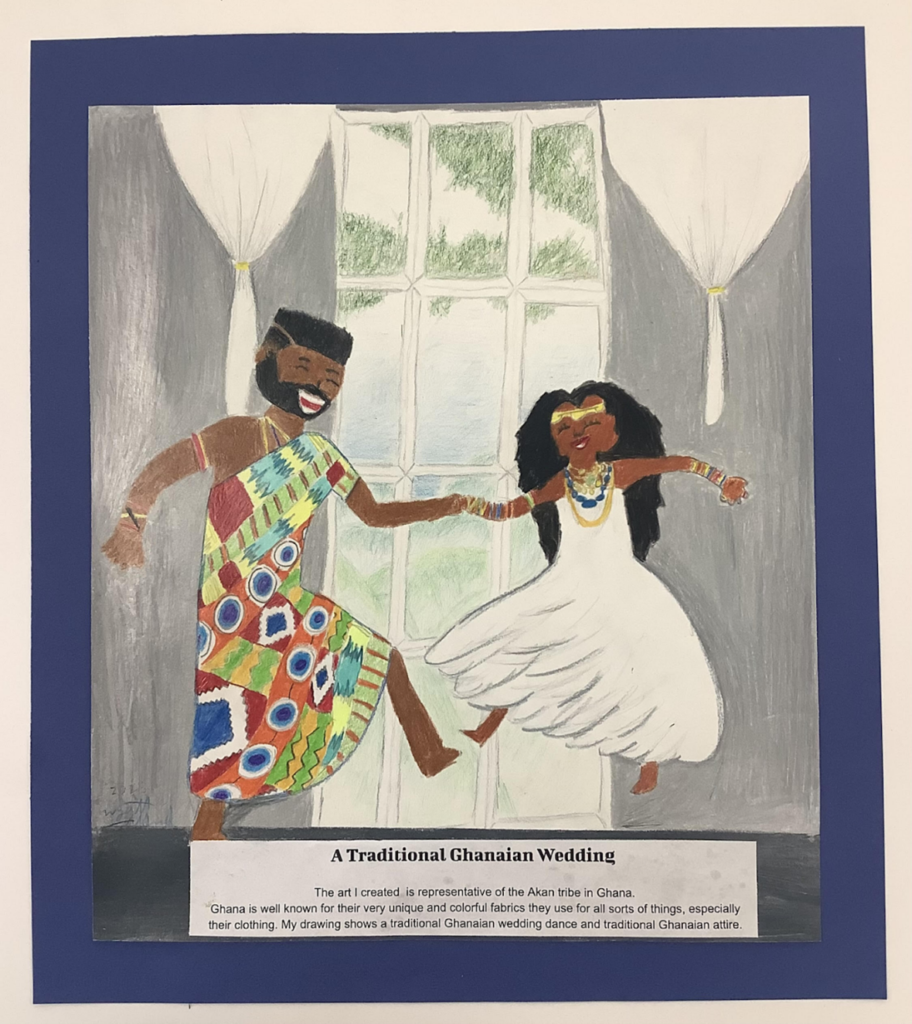
A Traditional Ghanaian Wedding by Wyatt Aldred
Mr. Baidoo who is from Africa and the current math teacher at Bessemer City inspired my artwork. He spoke to our class about his African culture and brought in some traditional African clothing. Seeing the amazing textiles he showed from New Guinea inspired my piece. My theme was a Ghanaian wedding and a Ghanaian wedding dance.
In a Ghanaian traditional wedding, the couple and the wedding party dress in traditional textile cloth to give the feeling of royalty. There is a presentation of wedding gifts to the bride and her family at the wedding venue. There is dancing and music aplenty, as entertainment plays a big role in the celebrations.
I wanted to capture the celebration of the wedding couple through dance. The background of my art represents the Natural surroundings.
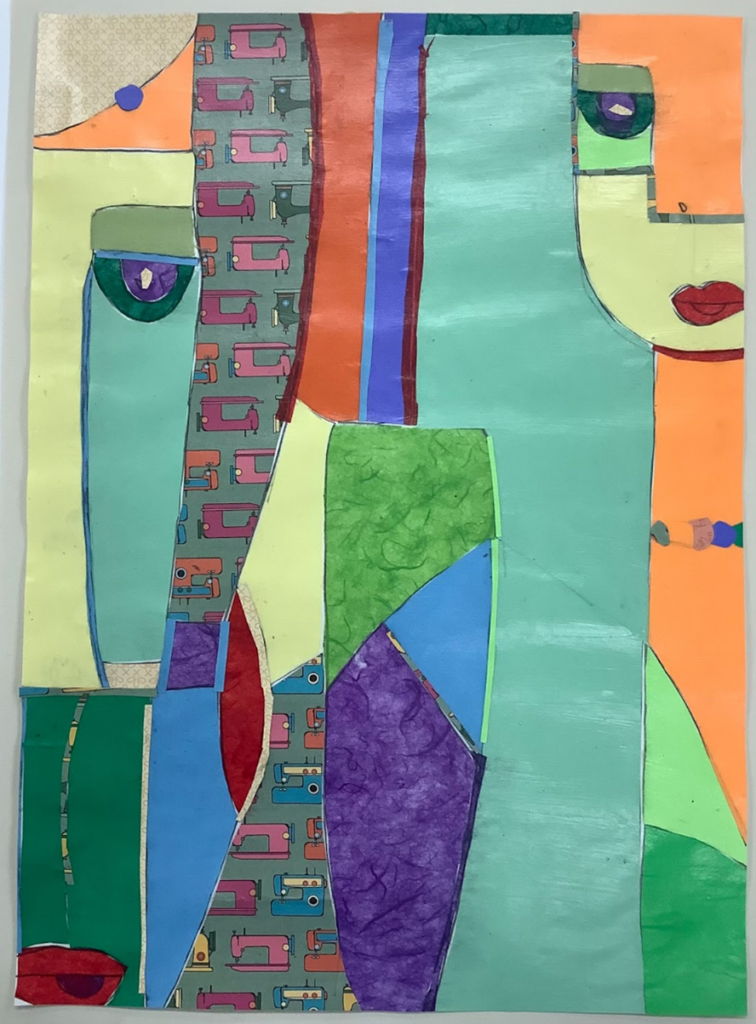
Himba Tribe by Amber Cline
My African art is based on the Himba tribe. I chose this tribe because it’s very unique to me, the colors and also the history behind it is very interesting. I love my African created because it has its own unique style, unlike any other type of art! Most African art is based on religion, rituals, textiles and ceremony.
Males wear loincloths and sandals for footwear, with foot soles often found made from old car tires, as the men and boys tend to the cattle and herd their goats all day. The woman on the other hand tends to the village wearing goat-skinned skirts. I would say that is very creative. The main colors in my art are different shades of green, because that was the main colors of the tribe chosen, Himba Tribe. Another interesting face is they different coloured tiles to put together a baseline of colour groupings according to the Himba language. What they found was intriguing. Western languages have eleven colour categories, ie. green, blue, yellow, red, white and so forth, but the Himbas only have five
I chose a collage for my piece. I love everything about this project from the different colors and patterns. I combined many different patterns and textures to show how unique the tribe and their art. I would label the art as a unique piece of art! I enjoyed putting everything together and seeing the outcome!
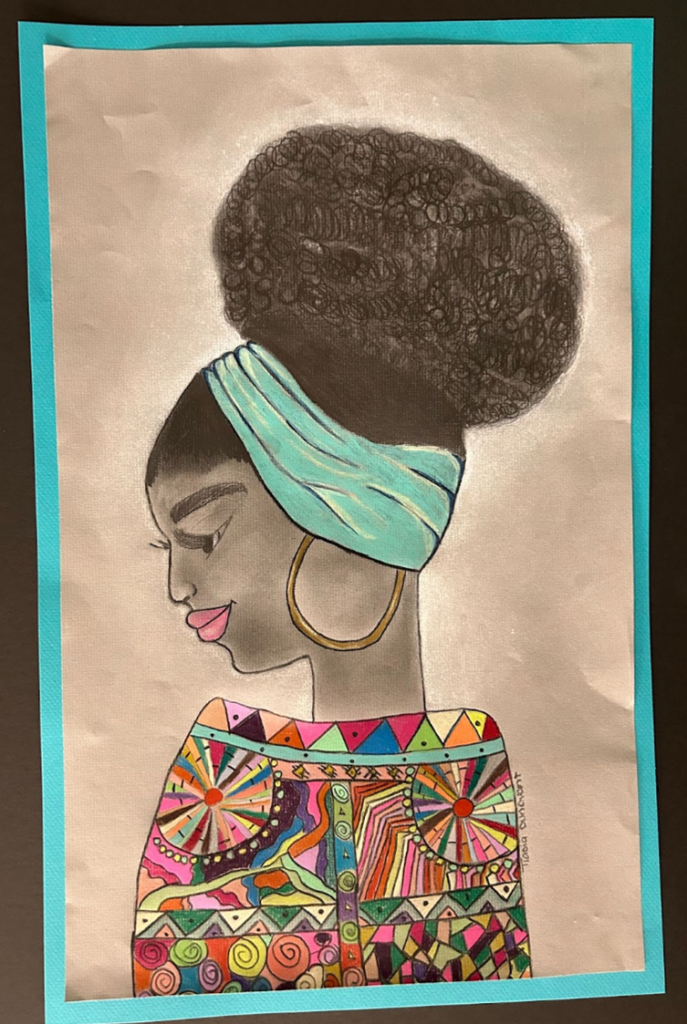
African Woman by Tiasia Dunovant
For my artwork I chose this beautiful African Woman. This woman is expressing her hair , her clothing, the vibrant patterns, the earring and she’s showing her skin color. I like my artwork because of the texture of the hair the swirl and the darks to lights. The practices dates back to pre-colonial African history in sub-Saharan Africa, and head wraps are considered symbols of status, marriage, and family lineage. African head wrap symbolize a woman’s spirituality, wealth and social status within a community
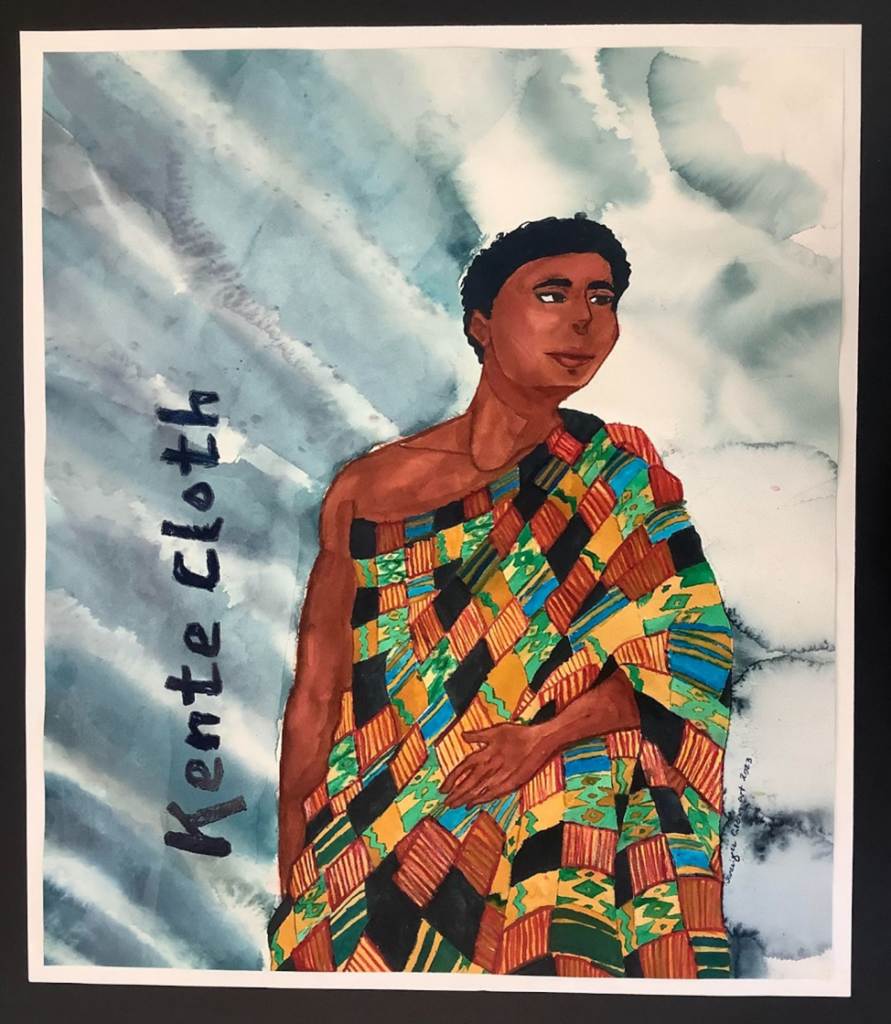
Kente Cloth
By Janaiya Glenn
The word Kente means “basket” referencing its basket-like patterns.
In the Asante dialect of the Akan Language, Kente cloth is made from a handwoven cloth,strips of silk and cotton. Kente cloth originated from Bonwire in the Ashanti region of Ghana.Historically Kente cloth was worn by the Akan, wrapped over their shoulders in the style of Roman toga, with this cloth being worn by royalty. Kente cloth was originally used only to dress the kings and their courts.
Women may also wear Kente cloth and may wear it in different combinations. Women can wear Kente cloth in one large piece or have a combination of three or two pieces of varying sizes. Social standing,marital status ,and age can determine the size and design of Kente cloth the person may wear. Kente cloth is intended as a form of communication by the use of the colors and design. In West Africa among the Ashanti people of Ghana.
There is a story about Kente cloth and how it was said to be made. The story is about how two young men went into the forest to check on their traps. In doing so they saw a beautiful spider web. The spider web had many unique designs. Ananse, the name of the spider had offered to show the men how to weave in return for favors. When they had returned to Bonwire, their discovery was reported to Asantehene Osei Tutu, the first ruler of Asante Kingdom. The Asantehene adopted the creation, and named Kente an royal cloth reserved for special occasions.
In Kente cloth each color has a different meaning. With gold or yellow meaning wealth and royalty, Black represents Maturity and spiritual strength, Red symbolizes strength, blood and political passion, and Blue stands for harmony, love, and peace. Green represents renewal, growth, and harvest. The last color being white symbolizescleansing rites, festive occasions, and purity.
I created this project because of a lesson our school’s math teacher had put together about his country Ghana, in Africa. He had talked to us about textiles ,and how beautiful they can be despite its complexity sometimes. He also told us about how everything in Ghana has a meaning, from the way you wear it to the minerals being worn. What had interested me in his lesson was how the different types of textile cloth can have different meanings and can be used for different occasions.
Out of all the different types of textile cloths, I chose Kente cloth because of how the colors and patterns mean different things and the story that went along with it. What I have learned from this project is that this cloth may look one way to us but in reality it is telling us different things by using the different colors and patterns represented in the cloth.
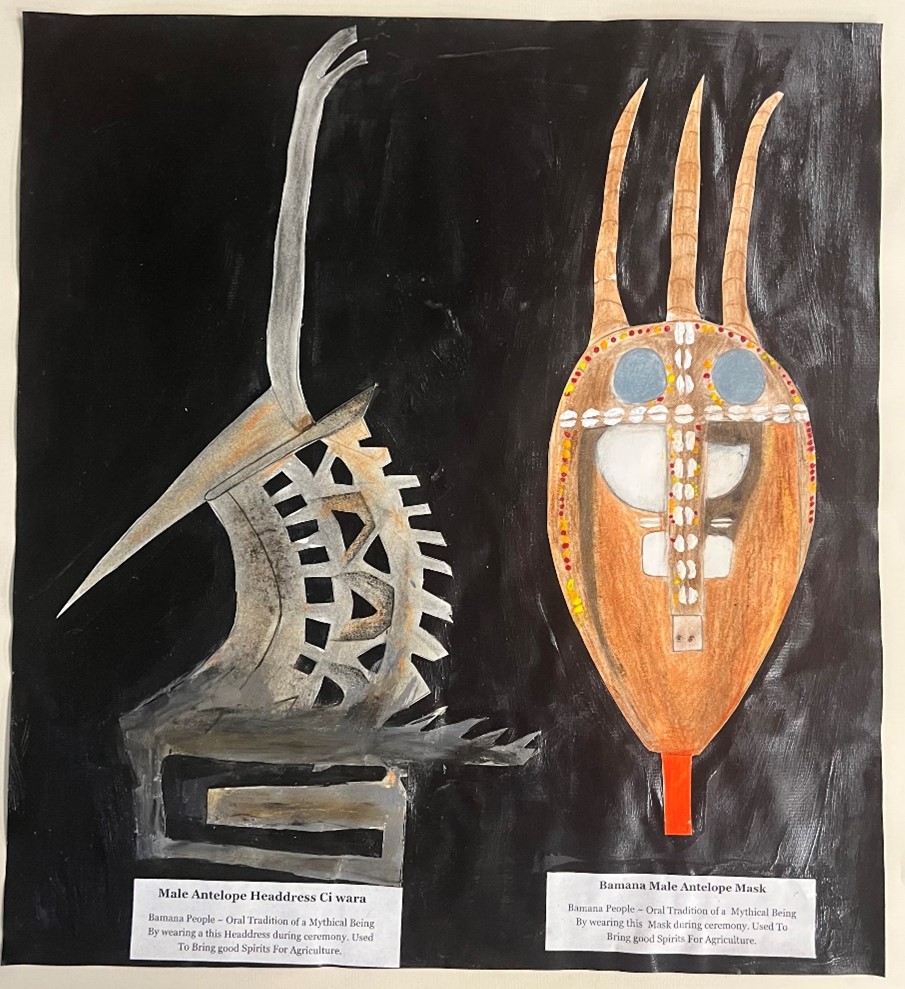
Male Antelope Headdress and Male Antelope Mask by Liliana Hoyle
In my artwork, I drew a Bamana headdress and a Bamana mask. The Bamana are a large and influential ethnic group in Mali, West Africa. The political structure is patrilineal, meaning positions are inherited and handed down through the male side of the family. Adulthood is earned through the process of six major initiation societies, collectively called the jow, which is used as both a religious and educational system. Bamana males go through all six of the societies to be able to marry and start their role in adulthood, while Bamana females go through just one initiation society. Each of these different societies within the Bamana culture has its own unique masks.
The mask in the collection is made from wood and crowned with three animal horns. The horns are long and swoop back from the front of the mask. The face of the mask is oval-shaped with a long nose. The nose, forehead, and temples of the mask’s face are decorated with cowrie shells and red and orange abrus seeds. Four small circular mirrors are positioned above the eyes on the left and right sides of the mask, and two small rectangle mirrors appear on either side of the mask. Small circle-shaped ears are carved above the rectangle mirror on the cheek area of the mask. The other rectangle mirrors are placed on either side of the nose. The mask has no mouth.
Among the Bamana, oral traditions credit a mythical being named Ci Wara, a divine being half mortal and half animal, with the introduction of agriculture to the Bamana. Bamana society is primarily an agricultural one; even today the majority of Bamana people are subsistence farmers. These headdresses, also called Ci Wara, are carved to honor that original mythical being.
When humans gradually became careless and wasteful, however, Ci Wara is said to have buried himself in the earth. To honor Ci Wara’s memory, the Bamana created a boli, a power object in which his spirit could reside, and carved headdresses such as these to represent him.
I created this art piece to portray agriculture. I feel like agriculture is something that is special in all cultures and you need it to thrive as a society. Protecting the earth and giving it the love it needs is what Ci Wara stands for, and I think that is why I’m so drawn to this. I think Ci Wara is a beautiful being and stands for something I love, Earth.

The Kenyan Prodigy by Ari’ana Irby
The Woman, specifically the Kenyan woman is known for her resilient, hardworking, creative, and loving nature. Also known as the best cooks, Kenyan women are often oppressed in their own country even in cognizance of all their contributions to their society.
Women are often expected to be obedient to their husbands as well as not to challenge or disagree with their views. With my artwork, I wanted to portray the fact that women, more specifically Kenyan women are humans who sing and dance and want to have fun. There is still a dismaying amount of gender-based violence and women are still underrepresented in the decision-making processes in Kenya. Women and girls still spend long hours doing household chores and such.
In my artwork, the colors in the background were specifically chosen to represent the environment in Kenya which is made up of a desert biome, a savanna biome, and a rainforest biome. The colors I use represent the desert biome of Kenya which happens to be the most common biome in Kenya. I use these orange-tan colors to represent the color of the grassy plains and also to represent the colors of the sunsets and sunrises in the savanna.
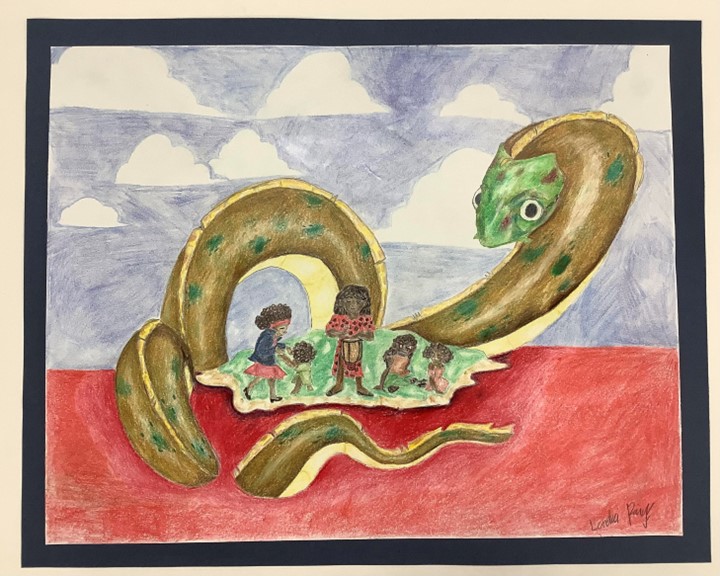
Nyami Nyami by Lorelai Paige
What did I draw? I drew the mythological creature of the Tonga People called Nyami Nymai. A hybrid between a snake and a fish, it has the head of a fish and the body of a snake. I drew the Nyami Nyami as it surrounds the people because I feel like it shows the protection of the Nyami Nyami for the Tonga people. The people being protected by the Nyami Nyami in the drawing are celebrating and happy.
The Nyami Nyami, also known as the Zambezi River god or the Zambezi Snake Spirit, is one of the most important gods of the Tonga people.

Origin of Head wraps by Rosianny Paz Gutierrez
I chose to draw this because I wanted to know the meaning of the hair wraps that African women wear. I did some research and found out that head wraps originated in Sub-Saharan Africa in the early 1700’s and soon became prevalent among Nubian queens in Egypt. Head wraps had distinct meanings depending on the color and pattern. In the beginning of the 18th century, these designs communicated a woman’s cultures and family practices. For some cultures, head wraps indicated a high social status along with which a woman’s marital status was indicated, from being engaged up until the marriage.

African Art by Erica Pineda
For my art project I did a drawing of what it looks like when they carry stuff on their heads and how they balance it so well but also because this drawing that I did I wanted to make sure it had all the good colors to represent all the colorful clothing they wear. So let’s start with why they carry it on their heads. They do it because it happens to be well suited to the rough and rural terrain and the particular objects they carry like wood, water, and different types of fruits and vegetables.
Why do they wear the clothing they do? The fabric often reflects the society in general as well as the status of individuals or groups within that community. In some instances, traditional robes have been replaced or influenced by foreign cultures, like colonial impact or western popular dress code.
How do they balance everything on their head? They wear a soft cloth or towel on top of the head to protect the skull. It’s simply the best way they know how to carry heavy loads. You can’t just wake up and say you want to place or carry a heavy load on your head. They have learned to carry things on the head since childhood.
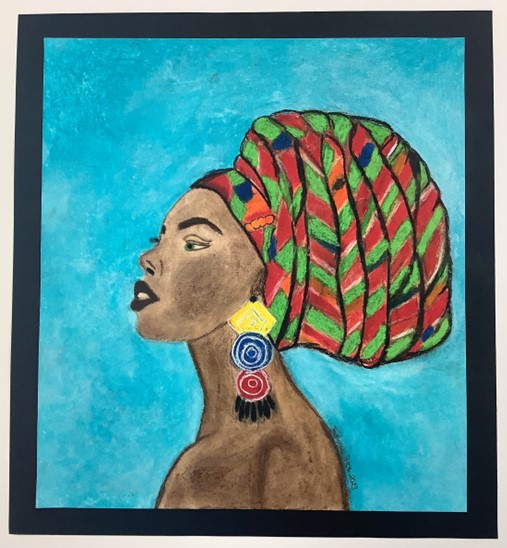
African Headwraps by Jasmine Price
I chose to do this artwork because I feel like people should learn more about the headwraps and why people wear them. The information that I found I feel like it reached out to me and I learned new things about different cultures. I feel like people should learn more about different cultures to open more of the world. After doing research and finding new information I found that head wraps originated from Sub-saharan Africa. It’s interesting because they are not only a fashion statement, but also have deep cultural and historical significance. In many African countries, headwraps are used to represent one’s social status, ethnicity, and even marital status. They are also worn to protect the hair from damage and to keep it clean. Headwraps are often used as a form of self-expression, with different colors and patterns symbolizing different things. Overall, headwraps are an important part of african culture and have been worn for centuries.
Also, headwraps have always been used for practical reasons by many women in Africa and beyond. Traditionally, African ladies would wear headwraps to protect their hair and heads from the strong sun and keep cool in the hot weather.
When Women wear headwraps with the ends facing down it means a woman is married and if worn with the ends up, she is single.
The headwrap originated from Africa and is traditionally worn by women in many different countries. They are called ‘Duka’ in Ghana, ‘Gele’ in Nigeria and ‘Doek’ in South Africa. The chosen style of head wrap worn by African women can display information about their marital status, and social and economic background. More information that I found is that African women have worn head scarves for many years for religious, cultural reasons traditionally, worn by older, usually married women. They are a common feature in ceremonies such as weddings and even funerals, as known as headwrap.
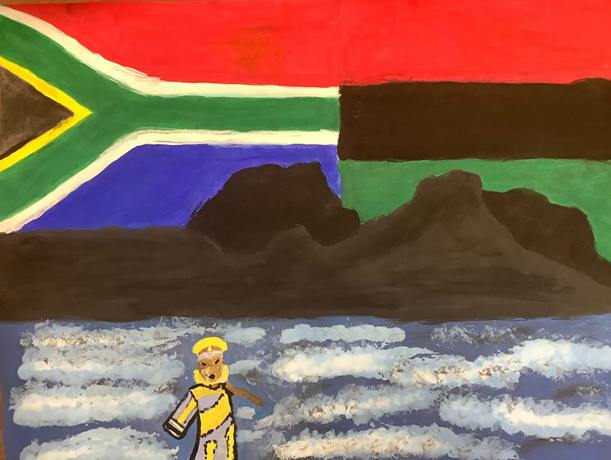
Flags & Landscape By Corey Sanders
I made this artwork inspired by the land, culture and colors of South Africa. In my personal opinion, South Africa the most beautiful country in Africa. I used the South African flag as a background as well as a flag that represents the liberation of African people and the continent from European powers and other world leaders. This flag is called pan-African flag. Just under that I used the mountains of Cape town, which is a group of mountains right by the shoreline, a major city and port for imports and other goods. I also put waves and the ocean right underneath the mountains and the lady you see standing in the water is wearing a piece of clothing called a Venda. This is made from a blue and gold cloth and this is different for the male versions. She is also wearing a mask, which is a mask to represent the tribe and its hardships.

Dancing African Women by Robert Gillispie
In African societies, dance serves a complex diversity of social purposes. Within an indigenous dance tradition, each performance usually has a principal as well as a number of subsidiary purposes, which may express or reflect the communal values and social relationships of the people. In order to distinguish between the varieties of dance styles, therefore, it is necessary to establish the purpose for which each dance is performed.
There is something very unique about African dance. Although, in general, dance uses a progression of steps and movements to resonate with the speed and beat of a piece of music and coordinates the body in a cadenced manner, most African dances are segregated body movements that can be very hard to organize intellectually.
The drum is also a significant part of African dance accompaniment. It very well may be viewed as the heartbeat of a particular clan, expressing its collective state of mind and relating this collective energy with that of the ancestors. Drumming is often accompanied by handclapping or stomping of feet, and is complemented by chanting voices as dancers are moving in disciplined steps.
I choose to draw women dancing in the same movement to represent unity. The background is a pattern of African textiles to represent not only visual rhythm but to emulate the rhythm of drumbeats. Vibrant colors are used to honor the colors of African Culture.

Zulu Tribe by Brisayra Villamil Guzman
The inspiration for my art came from my mother’s love of flowers. I wanted to study a tribe that used flowers as part of their heritage and culture. Symbolism to represent the Zulu tribe was the textile patterns and the other being the native flowers that grow in the region.
Zulu, a nation of Nguni-speaking people in KwaZulu-Natal province, South Africa. They are a branch of the southern Bantu and have close ethnic, linguistic, and cultural ties with the Swazi and Xhosa. The Zulu are the single largest ethnic group in South Africa and numbered about nine million in the late 20th century.
The main shape used in traditional Zulu beadwork is the triangle; the three corners represent Father, Mother and Child. The triangle used to indicate gender and marital status. If the tip is pointing up it represents an unmarried girl and if it is pointing down it means an unmarried boy.
Zuluflora‘s name derived from its home base, the area of KwaZulu-Natal. This is the Zulu Kingdom, a land with soil as rich as its history and stretched along the tropical eastern coastline of South Africa. And it’s the home of the finest proteas and nutans.
Another part of the assortment, like wax flower and Blushing Bride, is grown in the Western Cape area since they’re better suited there.

